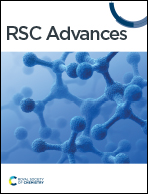Growth-control of hexagonal CdS-decorated ZnO nanorod arrays with low-temperature preheating treatment for improved properties and efficient photoelectrochemical applications
Abstract
The limitations of oxide semiconductor-based solar cells in achieving high energy conversion efficiencies have prompted incessant research efforts towards the creation of efficient heterostructures. Despite its toxicity, no other semiconducting material can fully replace CdS as a versatile visible light-absorbing sensitizer. Herein, we explore the aptness of preheating treatment in the successive ionic layer adsorption and reaction (SILAR) deposition technique and improve the understanding of the principle and the effects of a controlled growth environment on thus-formed CdS thin films. Single hexagonal phases of nanostructured cadmium sulfide (CdS)-sensitized zinc oxide nanorods arrays (ZnO NRs) have been developed without the support of any complexing agent. The influences of film thickness, cationic solution pH and post-thermal treatment temperature on the characteristics of binary photoelectrodes have been investigated experimentally. Interestingly, the preheating-assisted deposition of CdS, which is rarely applied for the SILAR technique, resulted in improved photoelectrochemical performance similar to the post-annealing effect. The X-ray diffraction pattern revealed that optimized ZnO/CdS thin films were polycrystalline with high crystallinity. Examination of the morphology of the fabricated films via field emission scanning electron microscopy showed that film thickness and medium pH altered the growth mechanism of nanoparticles, thereby changing their particle sizes, which had a significant influence on the film's optical behavior. The effectiveness of CdS as a photosensitizer and the band edge alignment for ZnO/CdS heterostructures were evaluated using ultra-violet visible spectroscopy. Facile electron transfer in the binary system as evidenced in electrochemical impedance spectroscopy Nyquist plots, therefore, promotes higher photoelectrochemical efficiencies from 0.40% to 4.30% under visible light illumination as compared with the pristine ZnO NRs photoanode.



 Please wait while we load your content...
Please wait while we load your content...